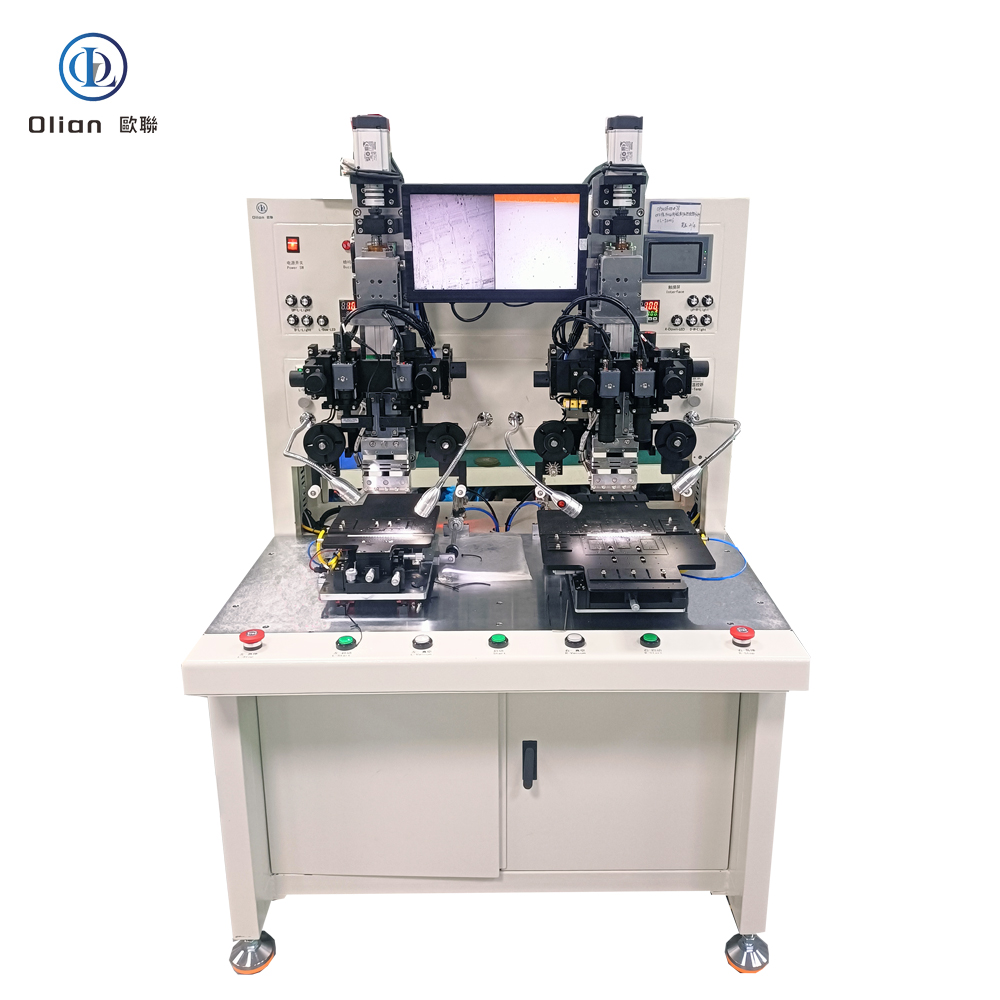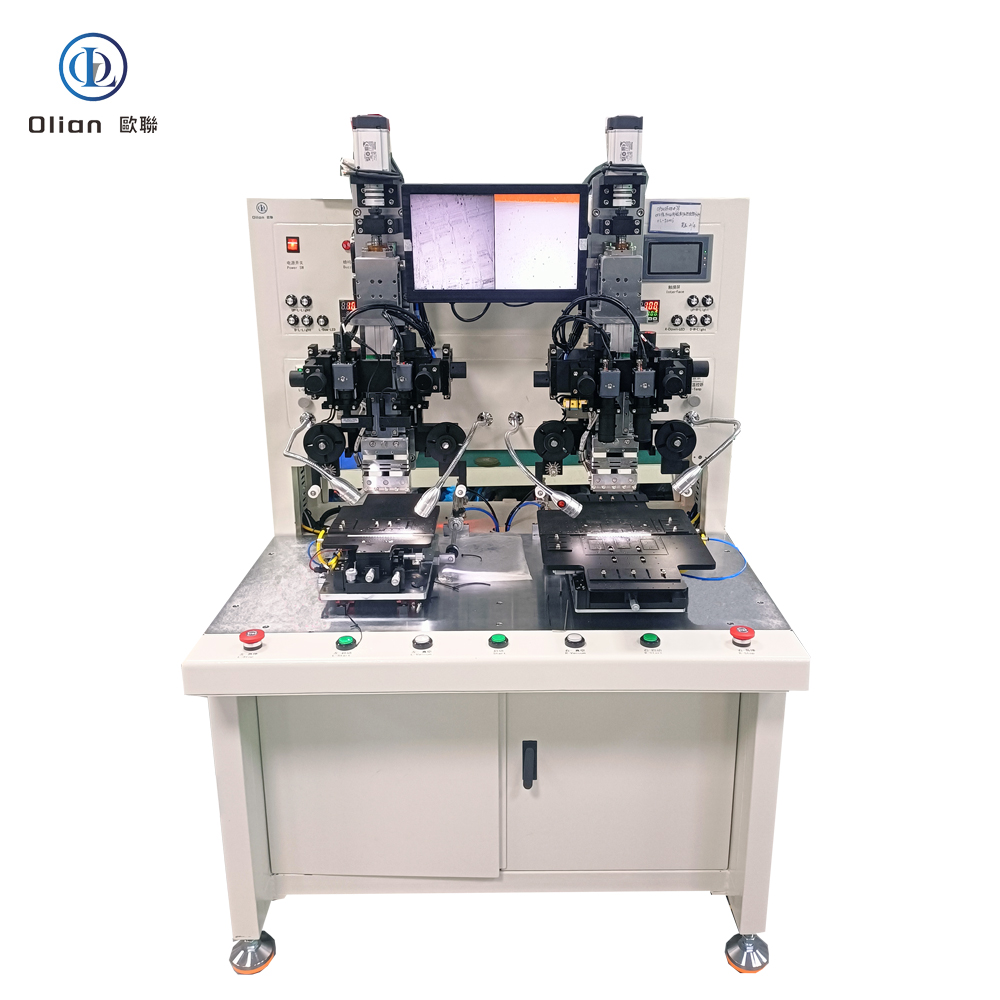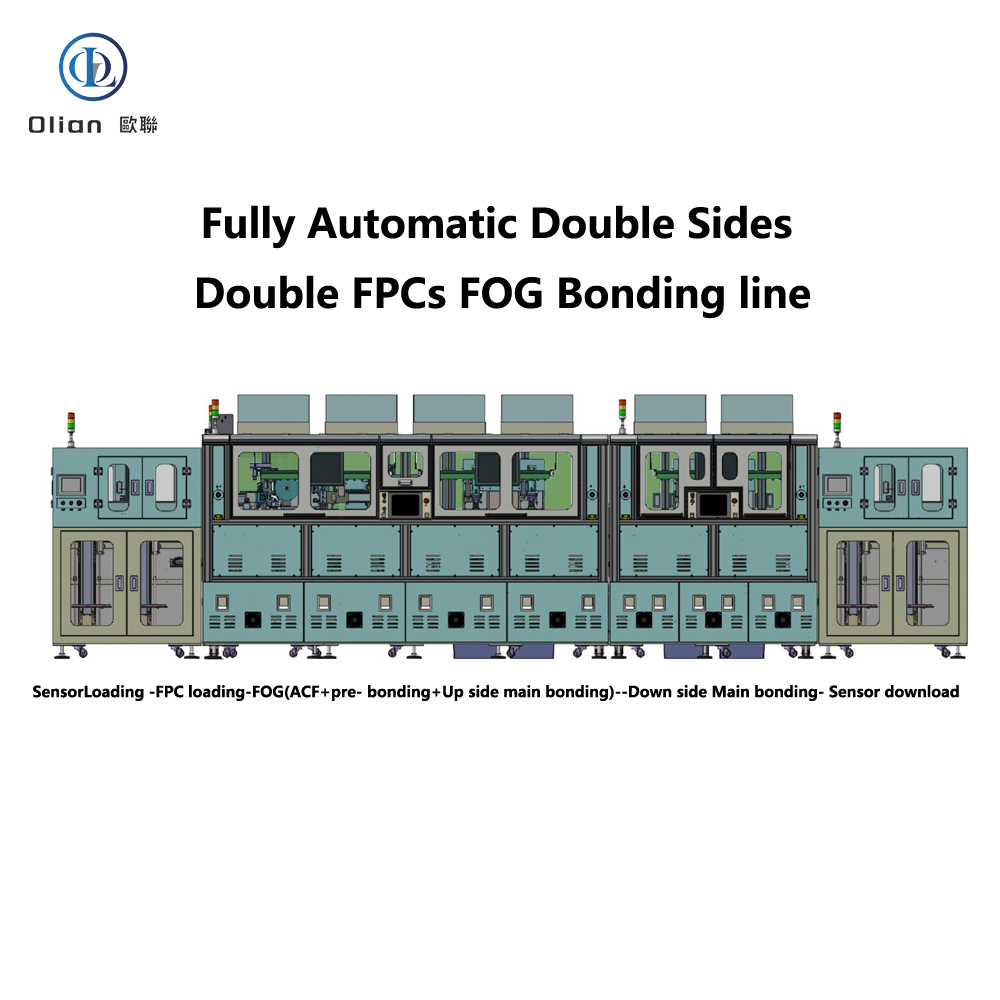

A FOB bonding machine—short for Flex-On-Board or Film-On-Board—is the critical link between a floppy polyimide tail and a rigid printed-circuit board. It grabs a flexible printed circuit (FPC), aligns it to a PCB within a single micron, and welds the copper traces together with anisotropic conductive film (ACF) in under three seconds. The result is a vibration-proof, heat-proof, lead-free joint that survives −40 °C automotive winters and +105 °C engine-bay summers. This guide walks through physics, hardware, software, specs, applications, trends, and maintenance rank you for “FOB bonding machine”, “FOB bonder”, “FPC to PCB bonding”, “ACF FOB machine”, “automotive FOB bonding”,








A FOB bonding machine is a servo-driven, vision-guided, pulse-heat press that laminates anisotropic conductive film onto a PCB, then bonds a flexible printed circuit (FPC) or chip-on-film (COF) tail to that PCB with micron-level accuracy. The film contains nickel or gold-coated spheres that conduct only vertically, giving thousands of simultaneous contacts while remaining insulated laterally. The same platform reworks defective boards by removing the old ACF and rebonding a new tail, saving a $200 automotive cluster or a $150 tablet mainboard.
Rigid PCBs cannot fold; wire harnesses fail after 10,000 vibration cycles; connectors add height and cost. FOB eliminates all three pain points by folding a 25 µm polyimide tail 180° with 0.2 mm radius and locking it to the PCB in a 2-second cycle. Automotive Tier-1 suppliers prefer FOB because it passes AEC-Q100 Grade 0 (−40 °C to +150 °C) without a single connector contact. Consumer OEMs love the 0.9 mm board-edge profile that enables edge-to-edge displays.
Bonding Head: Titanium alloy, diamond-lapped to 0.3 µm flatness, DLC-coated for anti-stick, lasts 300,000 cycles.
Pulse Heater: 800 W cartridge, embedded K-type thermocouple, ramp 200 °C/s, overshoot < 0.5 °C.
Force Actuator: Voice-coil or servo motor, 24-bit encoder, 0.1 N resolution, 2 ms response; active gravity cancellation for 25 µm PCBs.
Vision System: 12 MP global-shutter CMOS, telecentric lens, coaxial + side LED, sub-pixel edge detection repeatable to 0.2 µm.
Motion Stage: Cross-roller bearings, 0.05 µm linear encoder, servo feedback at 20 kHz, granite base with passive vibration isolation.
ACF Feed Unit: Stepper-driven, tungsten-steel cutter, anti-static vacuum, waste take-up spool, splice sensor for uninterrupted production.
Real-time Linux kernel guarantees < 1 ms jitter; PID temperature loop updated at 10 kHz.
Recipe manager encrypts parameters—temperature, pressure, time, ramp rate—per product QR code.
AI vision self-learns new pad patterns from PCB suppliers, reducing setup time 70 %.
MES interface via OPC-UA uploads cycle data, resistance values, and images for full traceability.
Cloud dashboard predicts heater degradation and schedules maintenance before scrap occurs.
Consumer Electronics: Smartphone mainboard, tablet battery flex, laptop keyboard backlight, smartwatch heart-rate sensor.
TV & Signage: 32″–100″ 4K/8K LCD, OLED, mini-LED—bonding source COF tails to main PCB.
Automotive: Curved instrument clusters, 15 inch OLED infotainment, head-up displays, camera modules—passing 1,000 h 85 °C/85 % RH.
Medical: Surgical hand-piece flex, portable ultrasound mainboard, wearable ECG patch—biocompatible polyimide, ISO 13485 traceability.
Industrial & Military: Avionics displays, factory HMI panels, rugged handhelds—shock, altitude, fungus per MIL-STD-810.
FOB bonding machine, FOB bonder, FPC to PCB bonding, ACF FOB machine, flex-on-board bonding, Film-on-board bonder, pulse heat FOB bonding, constant temperature FOB bonding, automotive FOB bonding, medical FOB bonding, 0.2 mm fold radius FOB, 25 µm polyimide FOB bonding, 100 inch FOB bonding, AI vision FOB bonding, IoT FOB bonding machine, China FOB bonding machine, automatic FOB bonder, FOB bonding accuracy 1 micron, FOB bonding temperature 200 C, FOB bonding pressure 1 MPa, vertical conduction horizontal insulation, lead-free FOB bonding, ROHS compliant FOB bonding.
Copper-Core ACF: Cu-Ag particles cut material cost 50 % while keeping < 20 mΩ contact resistance.
Green Refrigerants: Closed-loop cooling replaces water with R1234ze, reducing carbon footprint 30 %.
AI-Driven Profiles: Neural networks auto-optimize temperature ramps for each polyimide type, pushing yield to 99.9 %.
Micro-LED Bridge: Same FOB platform bonds 20 µm × 20 µm micro-LED dies onto flexible PCBs.
Cold-Laser Fold Assist: Femtosecond laser pre-scores the coverlay, enabling 90° fold with 50 µm radius and zero trace damage.
Servo-Hydraulic Hybrid: Delivers 80 kg force for 100″ TV FOB tails while keeping 1 µm position accuracy.
A FOB bonding machine is no longer a niche flex-to-board press—it is the critical enabler for foldable smartphones, zero-bezel TVs, curved automotive clusters, and biocompatible medical wearables that define 2025 consumer expectations. By mastering sub-micron alignment on 25 µm polyimide, pulse-heat control within half a degree, and real-time force feedback, the latest FOB bonders deliver sub-3-second cycles with 99.9 % yield and full Industry 4.0 traceability. Whether you are a display OEM chasing a 0.9 mm chin, an automotive Tier-1 qualifying radar modules, or a medical start-up prototyping flexible patches, investing in an AI-enhanced, IoT-connected FOB bonding platform future-proofs your process.